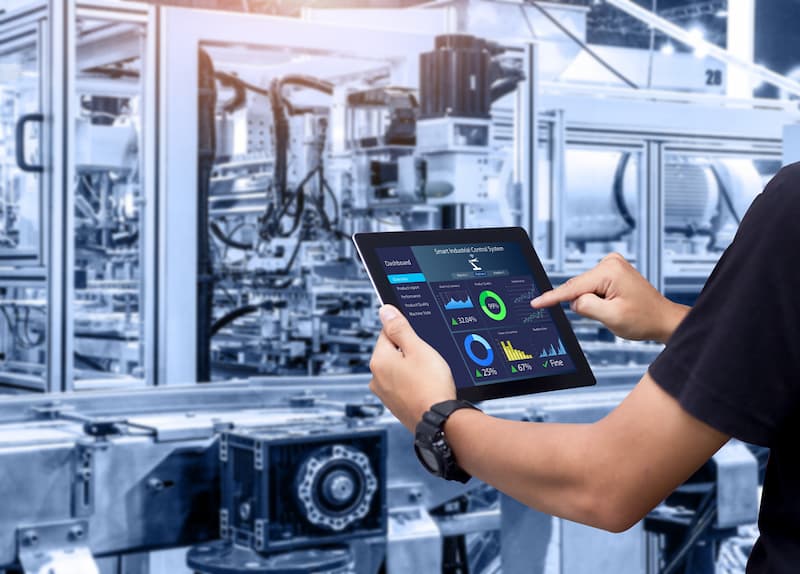Manufacturing is an industry that is constantly pushing the boundaries of technological advancement. The ever-increasing complexity of products and devices demands innovations in manufacturing their components to superior levels of quality.
One persistent trend in the growth of this vital industry has been adopting more digital and computerised processes. Wireless computer processes and CNC machines are well-known examples of how computers have helped push manufacturers to new heights previously thought impossible. Another example of these advancements is the smart factory.

What Is a Smart Factory?
One of the most significant advancements created for manufacturing is the smart factory. This term stands for a goal for manufacturing where digitisation has been implemented across the entire workflow, and productivity is increased as a result. Essentially, a smart factory is a system that constantly collects and shares data through a network of wirelessly connected management computers. These machines can be self-optimised to run mostly automatically but also have the added safety net of proactive human interventions from any location on the work floor. This allows facility managers to monitor and address daily working operations and ensure that everything runs smoothly.
There are many elements to creating a smart factory’s vision, including big data analytics, cloud computing and Industrial IoT; these are explained later. These elements cover a broad range of processes essential for manufacturing. Smart factories bring these disparate elements together to make a single comprehensive management system.
A fully integrated smart factory will create a reliable system for your manufacturing processes but also one that can be adapted and optimised to suit your specific needs.
Technologies Used in Smart Factories

Smart factory manufacturing relies on many digital functions working together. One example is by installing sensors across the work floor’s machinery. These monitoring devices collect vital data to be analysed at other steps in the process.
Industrial IoT
The Internet of things (IoT) creates interconnected machinery and processes with linking data systems. Data communication systems will exchange this sensor data between machines and any overall management system to track operations progress and status. If we were to disassemble the name, the ‘internet’ part is the method of data sharing and tracking, usually a wired or wireless network at your facility. The ‘things’ elements are the physical objects or digital processes providing the data being monitored. IoT assists with the efficiency of automated processes and provides increased control for operators and valuable operations data that can be analysed for further optimisation.
Cloud computing
Cloud computing is connected to the ‘internet’ element of the IoT. By decentralising your data and making it accessible remotely, you eliminate many unnecessary steps that can hinder the speed of your operations. Cloud computing is a concept many people are familiar with thanks to the developments of online storage systems, and while this is similar, there are differences. This cloud computing setup will be limited to just authorised personnel and should be protected with adequate cyber security.
Big data analytics
This data analysis is the element that allows you to explore new, beneficial ways of improving your business. Spring manufacturers are one of many organisations that embrace these analytics as ways of discovering patterns lacking internally or finding market trends externally. For manufacturers, big data analytics ensures the processes currently enacted are the best they can be.
Multiple Levels of Smart Factory

A smart factory isn’t a binary concept. Instead, because of the varied nature of applying these digital enhancements, there are several levels of a smart factory, with most manufacturers at one of these levels.
Level one: Read-only data
This initial level of data is one that most manufacturers will be on. This level is where you have data available, for it’s not easily accessible. Collecting and analysing data from this level will involve manual work that is time-consuming and prone to human error.
Level two: Available data
This second stage of data is not only accessible but also in an organised fashion. This is where all the information you need can be found in one location. This can be visualised in many forms, such as graphs, tables and dashboards, to make digesting the data easier at a glance. At this stage, proactive analysis can be conducted to provide new ways of conducting operations.
Level three: Interactive data
Data is now organised, readable, and analysed by AI (artificial intelligence) software to automatically provide insights with limited human interaction. A system at this level will be able to identify issues on its own and predict potential problems proactively.
Level four: Proactive Data
At this final stage, a manufacturer employs machine learning to create actionable solutions to the issues revealed during big data analytics. The system is highly automated and can execute new changes without human intervention.
Benefits of Smart Factories

Smart factory manufacturing relies on digital technologies to function. Hence, the digital growth of the industry has been labelled the fourth industrial revolution, Industry 4.0.
The essential benefit of smart factories is the data collection they provide. By providing you with all the data quickly, you are free to make fast decisions and improve your business. Smart factories can essentially collect data, analyse it for issues and generate solutions, all with minimal human input. This concept significantly increases a manufacturer’s efficiency across every aspect, financial sustainability or operations.
At Airedale Springs, we embrace innovations such as Industry 4.0 as part of our goal to constantly improve our current operations. In addition, as compression spring manufacturers, we embrace digitisation as an essential part of improving our work and providing a better service for our clients. Learn more about our processes as an experienced compression, tension and torsion spring manufacturer here.

